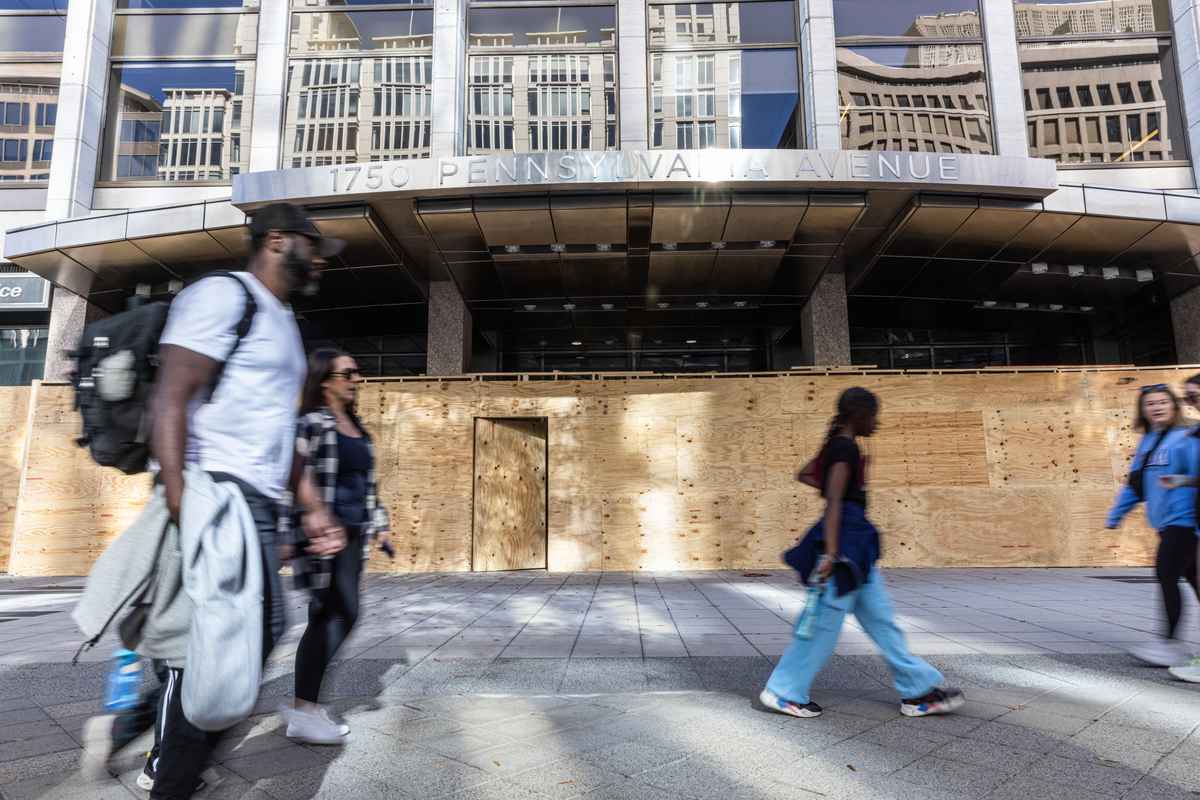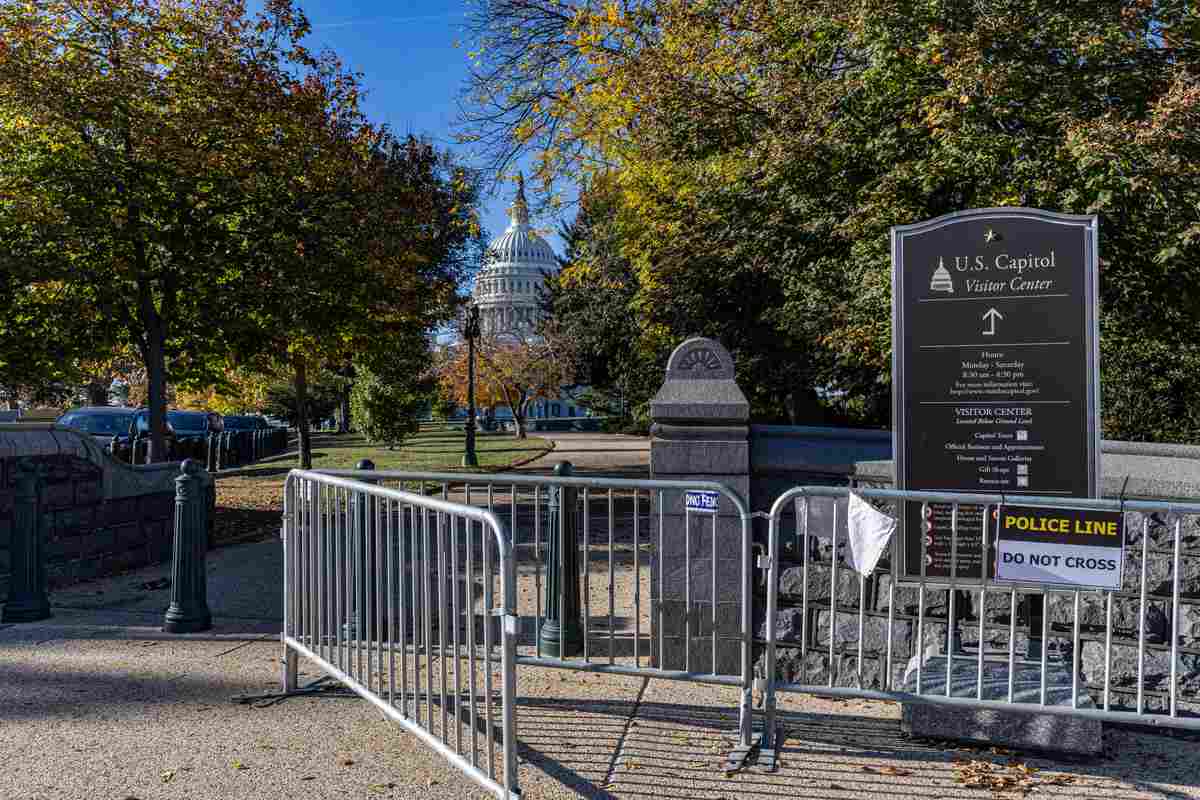
People walk by an office building Saturday on Pennsylvania Avenue, a few blocks from the White House, now boarded up in preparation for the election.
14:20 JST, November 4, 2024
Rings of new security fencing enveloped the White House, U.S. Capitol and Vice President Kamala Harris’s residence on Sunday as federal and District authorities braced for potential unrest in Washington following Tuesday’s presidential election.
For weeks, D.C. officials have sent messages of reassurance to residents and businesses still scarred by damage incurred during some 2020 racial justice and post-election protests. Authorities know of no credible threats, Washington’s police chief said at a news conference, adding there is “no need for any alarm.”
Still, signs of caution proliferated this weekend, as the Secret Service erected new, eight-foot-high metal fences around the White House and Treasury Department complex, and adjacent parts of Lafayette Square, as well as outside the Naval Observatory grounds and Harris’s residence. The Capitol reintroduced temporary bicycle-rack barriers posted with signs stating, “Police Line: Do not cross,” surrounding its perimeter. The agency also is installing physical security measures outside the West Palm Beach, Florida, convention center where Donald Trump will hold his election-night party, not far from his residence at Mar-a-Lago.
“The Secret Service is working closely with federal, state and local partners in Washington, DC and Palm Beach County, Florida to ensure heightened levels of Election Day safety and security,” the agency said in a statement Sunday. “These enhancements are not in response to any specific issue but are part of wide ranging public safety preparations for Tuesday’s election.”
As authorities worked to fortify public assets, some business and property owners braced for the worst, surging private security, shoring up street-level windows and entrances, and finalizing contingency plans in anticipation of possible looting or rioting. Owners of commercial buildings near the White House boarded up or added fencing outside street-level businesses and shops, with business association leaders saying they would rather overprepare than sustain damage in the event of street violence, although District officials have said there is no need to cover windows.
“There is concern around the city. We’re not expecting full-fledged pandemonium like we saw after Jan. 6, [2021,] or four years ago,” said Eric J. Jones, the vice president of government affairs for the Apartment and Office Building Association of Metropolitan Washington, whose members own 76 million square feet of commercial office space and about 110,000 apartment units in the District.
“Honestly, it’s just fear,” Jones said, adding that some retailers far removed from downtown worry about opportunistic looting with police attention focused elsewhere. “I’m getting constant emails and text messages because people are really engaged. … People would rather be overprepared and have nothing happen, as opposed to the alternative.”
Washington is no stranger to public demonstrations, and has seen only sporadic violence in the decades since the destructive April 1968 riots after Martin Luther King Jr.’s assassination. During the inauguration of President Donald Trump in 2017, authorities estimate unrest yielded about $100,000 in property damage across 16 blocks downtown.
Still, memories of residents and business owners remain seared by the unrest of 2020, including several days of protests that May after the murder of George Floyd, and several post-2020 election demonstrations that culminated in the deadly Jan. 6, 2021, Capitol attack.
Several street-front businesses were damaged and a basement fire was set at the historic St. John’s Church on Lafayette Square across from the White House in early June 2020, after Trump ordered the clearing of mostly peaceful demonstrators at Lafayette Square. After Jan. 6, security fencing was erected and stood for months around several blocks of Capitol Hill, leading residents and community leaders to describe the area as a fenced-off fortress.
Leon A. Beresford, executive vice president of Admiral Security Services, which provides security guards to 150 commercial office buildings in D.C., said the company is mobilizing roughly 2,000 private personnel to be ready to work 12-hour shifts at its client facilities concentrated around the White House, along K Street NW and surrounding Freedom Plaza on Pennsylvania Ave NW between the White House and the Capitol.

Temporary bike-rack barriers are installed at the Capitol as part of enhanced security measures.
Private businesses have been advised to be ready to beef up staffing of security guards, engineers, janitors and maintenance workers in case of damage; to secure materials to deploy fencing, gates or other barriers if needed; and to practice procedures to secure or evacuate buildings, he and Jones said in separate interviews.
“At a time when we are trying to revitalize, especially our downtown core, what we don’t want is destruction of property that discourages folks from coming back to the city, or that creates a situation where we are trying to rebuild those areas,” Jones said in an interview.
District government leaders and agencies have spent many months planning for the post-election period, determined along with residents and businesses not to be caught off-guard, as they were four years ago, and to ensure a safe and secure environment for visitors, tourists and students through the winter.
All eligible 3,300 D.C. police officers will work 12-hour shifts with most leave canceled through at least the election, Police Chief Pamela A. Smith said last week, “to ensure we have enough officers on the street and in every corner of the District.”
D.C. Council Member Brooke Pinto (D-Ward 2) expressed a similar sentiment. “Across the DC government we have prepared and coordinated with federal partners to ensure the safety of DC residents and visitors throughout the election and inauguration,” Pinto, whose ward spans much of downtown, said in an emailed statement. “Violence or destruction will not be tolerated. … I am also encouraged that our small businesses, hotels, and restaurants and bars are ready to benefit from residents and visitors coming to the District throughout this season.”
Still, Beresford said, D.C. police and commercial building owners are among the most practiced in the country in dealing with street protests and associated violence. “When I go to Florida, they’ve got hurricane response down there, and it’s incredible what they’re able to do with natural disasters,” he said. When it comes to civil unrest, in D.C., “They’re battle tested, they’ve learned from past challenges there, and they’ve implemented a number of best practices there.”
Shaun Sharkey, owner of plant-based restaurant Pow Pow, said the decision to erect a wall outside his eatery at 1250 I Street NW at Franklin Park was not made by him, but in what he believed was a precautionary measure by the property manager, and that he hoped customers would continue coming in.
“We’re hopeful that the presence of the wall will not be misinterpreted, especially with the election approaching. Our intention is to continue fostering an inclusive atmosphere for everyone. We are also hopeful people can still find us,” Sharkey said.
"News Services" POPULAR ARTICLE
-

American Playwright Jeremy O. Harris Arrested in Japan on Alleged Drug Smuggling
-

Japan’s Nikkei Stock Average as JGB Yields, Yen Rise on Rate-Hike Bets
-

Japan’s Nikkei Stock Average Licks Wounds after Selloff Sparked by BOJ Hike Bets (UPDATE 1)
-

Japan’s Nikkei Stock Average Buoyed by Stable Yen; SoftBank’s Slide Caps Gains (UPDATE 1)
-

Japanese Bond Yields Zoom, Stocks Slide as Rate Hike Looms
JN ACCESS RANKING
-

Keidanren Chairman Yoshinobu Tsutsui Visits Kashiwazaki-Kariwa Nuclear Power Plant; Inspects New Emergency Safety System
-

Tokyo Economic Security Forum to Hold Inaugural Meeting Amid Tense Global Environment
-

Imports of Rare Earths from China Facing Delays, May Be Caused by Deterioration of Japan-China Relations
-

University of Tokyo Professor Discusses Japanese Economic Security in Interview Ahead of Forum
-

Japan Pulls out of Vietnam Nuclear Project, Complicating Hanoi’s Power Plans




















